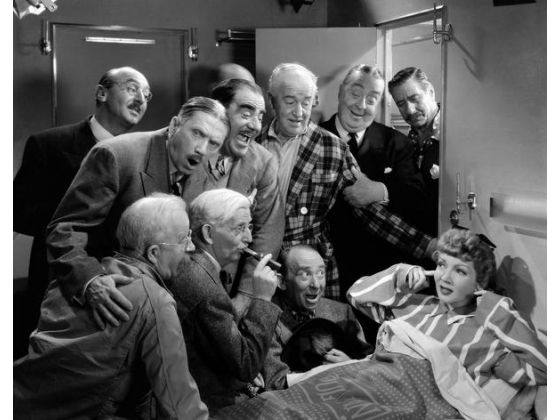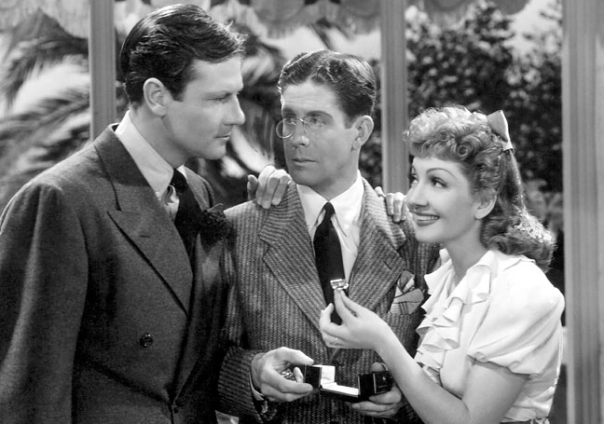The Palm Beach Story, Preston Sturges, 1942

One of the many things I like about Preston Sturges is that he’s all over the place. It is not that he completely defies the Classic Hollywood conventional formula, but that he is not confined to it, and he plays with expectations. Even in the screwball comedy genre, he’s a bit of a loose cannon and less predictable. The Palm Beach Story is even more out there than others, like the soon to be upgraded Sullivan’s Travels (which, to be fair, is not exactly conventional either).
While the overall journey does not sound too far fetched – they start in New York, take a train to Jacksonville, and then boat to Palm Beach – it is the detours along the way that make this truly a Sturges picture. Tom (Joel McRea) and Gerry (Claudette Colbert) are the true leads and get the most screen time, but they share it with plenty other colorful characters. It is not the Capraesque manner of portraying two primary characters with some dimension and flattening all the others around him, such as in It Happened One Night, also with Colbert. He uses the supporting characters to give texture and flair.
All of the characters are a lot of fun, whether they are major or minor, but I am going to touch on the best of the supporters.
My favorite batch of supporting characters is the band of drunken hunters that take Gerry under their wing and give her access to their train car. They are introduced one-by-one, all with ridiculous names, but not to the extent that they could all be totally made up, just far from the norm. When they get on the train and start drinking, they are a delight. Two fellows start a competition where they will shoot crackers in the cabin, which a racially insensitive stereotypical African-American porter (unfortunately, this was common to the era) would reluctantly throw the crackers up in the air. At first one drunken gentleman seems to think they are merely miming the shot, which itself is a little silly since there could be no way to prove which is a hit. The reality is even more outrageous. The man loads a live round into the chamber, and succeeds in hitting the cracker, shooting out the train window in the process. They do it again, and eventually the entire Ale & Quail Hunting Club are shooting toward the train window, destroying the entire cabin. Rather than deal with drunks with guns, the conductor simply detaches their car and goes on without them.
The next two characters are the ultra-rich descendants of the Hackensacker family (an obvious mockery of the Rockenfellers). John D enjoys the idea of paying for whatever Gerry needs along the way, which includes a wardrobe since hers was on the Ale & Quail car. He even meticulously writes down each amount, although we learn later that the total bill means next to nothing to him. He could own the store without blinking. His sister, Prince Centimilla (Mary Astor) is later introduced, and they are both humorous in their pursuit of married couple that are playing as brother and sister. The best comic relief is Toto, who bears more than a passing resemblance to Carlo from My Man Godfrey as the jilted sponge who passive aggressively allows himself to be cuckolded for a free meal ticket.
The most outlandish part of the feature is the ending. I won’t reveal the specifics, but it is a form of a deus ex machine (sort of), which comes completely out of left field. There are some films that I see this type of ending as sloppy and lazy, but here it is completely appropriate with the zaniness that has taken place during this romp to South Florida.
Film Rating: 8/10
Supplements:
James Harvey – This is a critical analysis from Harvey, a film scholar. He talks about Sturges origins with screenplays and B movies, and how he made his way up the ladder with Paramount.
Sturges came from a rich upbringing, which explains why he focuses often on the upper classes and lampoons them with such precision. His adopted was Solomon Sturges, who had acquired a great deal of wealth in the stock market. Despite not being his real father, the two were very close.
As I noted above, Struges’ comedy was too far out to be appreciated by the mainstream. The Lady Eve was a big hit, but Palm Beach and Sullivan were failures. Despite another big hit with The Miracle of Morgan’s Creek (which I would LOVE to see on Criterion someday), Paramount let him go and aside from a couple successes, his career mostly went on the downturn. He became a favorite of French critics like Andre Bazin, who liked him and hated Capra, so his work has been rediscovered and celebrated in part thanks to them.
Bill Hader – This is an odd choice for an interview since Hader is not necessarily a film scholar, but he clearly has an appreciation for classic comedy and he is unquestionably an authority on modern comedy. He spends most of his interview with a Sturges script book, just reading some of the dialog and cracking up at it. The words read as funny as they sound spoken, and sometimes even funnier. He remarks that a number of comics and filmmakers were inspired by Sturges.
Safeguarding Military Information, 1941 – This is a short propaganda film made during the war to prevent people from unwittingly spilling military secrets in public and possibly compromising the safety of our military. It plays out as one would expect from a propaganda film, whether American, German or Russian. One segment had Eddie Bracken, who would star in two major 1944 features for Sturges, the aforementioned Morgan’s Creek and Hail the Conquering Hero.
Criterion Rating: 7.5/10
Posted on February 9, 2015, in Criterions, Film and tagged claudette colbert, criterion, film, joel mcrea, mary astor, palm beach, preston sturges, quail & ale club, rudy vallée, screwball comedy, sig arno, the criterion collection. Bookmark the permalink. Leave a comment.




Leave a comment
Comments 0